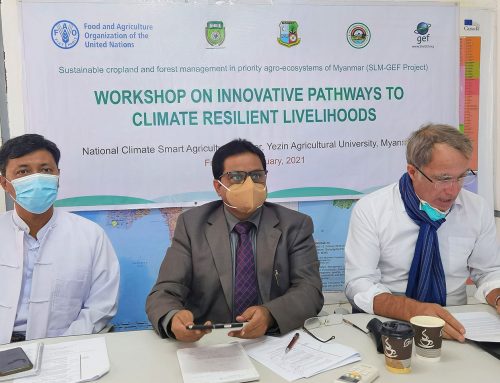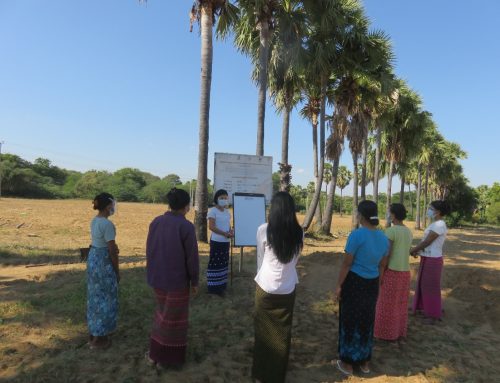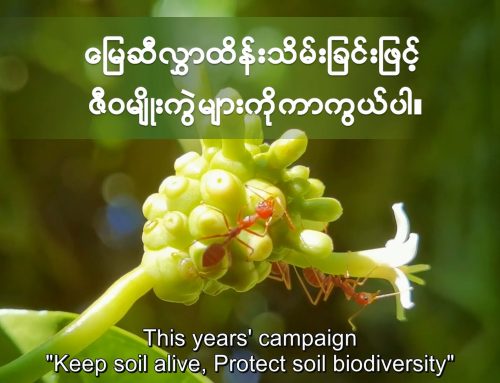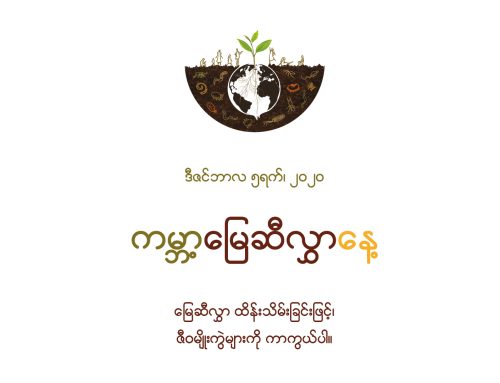Daw Htay Htay Naing, a farmer from Sin Tat Kyin village in Kyaukpadaung Township, who is not a Farmer Field School (FFS) participant but she is only a neighbor of some FFS participants expressed the following message:
“The farmer field school participants from the training told me that t growing Shaw-Phyu (Sterculia versicolor) can increase income and it can be planted with other crops by using the concept of Agroforestry. Even though I didn’t attend farmer field school, I wanted to try and then I did”.
The Farmer Field School training is provided in Sin Tat Kyin village by the project, “Sustainable Cropland and forest management in priority agro-ecosystems of Myanmar (SLM-GEF)” in coordination with DoA and Cesvi Myanmar. This village is only 5 miles away from the Kyaukpadaung township. There are a total of 30 participants from this village joined the FFS Committee and received regular training. Daw Htay Htay Naing couldn’t join the FFS programme in first round however, as she is always eager to learn new agricultural practices, she always tried to interact with neighbouring FFS farmers and observe the FFS demonstration plot to know and learn what new CSA practices are being introduced. After seeing the FFS demo plot established in Lead Farmer’s (U Htun Kyaung) field, she was really impressed and became interested in the concept of Agroforestry and asked the other farmers who joined the training about the details.
Daw Htay Htay Naing explained, “Traditionally, we know only about climate smart agriculture is in the timing of tillage and how to line up for row spacing, regular harrowing and plowing. Now, I understand covering soil (soil mulching), zero tillage or minimum tillage, using natural fertilizers and agroforestry system are the other similar practices. Growing Shaw-Phyu is good to get the shade, good for the weather, can grow together with other seasonal crops and is also a cash crop. So, I started to grow Shaw-Phyu since June 2018. I have no experience with growing Shaw-Phyu, using the concept of Agroforestry and growing pigeon pea. As usual, I had mostly experienced growing/production of Sesame and groundnut.”
Seeds were bought from a farmer who bought the seeds from Monywa Township. She bought four tins of Shaw-Phyu seeds from him with ten thousand kyats and then she planted the seeds. The total cost of one and a half lakh kyats was used for the labors. A villager/farmer near the interview told us cheerfully, “Her farm is really good and strong”. She has also used natural fertilizers (compost and fish amino acid) and mulching on her farm which increased the retention of soil moisture.
Currently, she is growing Shaw-Phyu and groundnut by applying the concept of Agroforestry. The planting duration is almost one year and the total 300 plants of Shaw-Phyu have been planted on her farm. Moreover, she would also like to know more about Climate Smart Agriculture and hence, she recently joined the farmer to farmer training organized by the SLM project in her village.
As it is clear from the photo, the crop performance in her field planted with the combination of groundnut and Shaw Phyu under agroforestry design is looking very good. Although it will need to wait for the income from Shaw Phyu tree about next 3 more years, she will receive annual income from the seasonal crops as usual and it will sustain for the long term when she starts receiving income from both Shaw Phyu (perennial crop) and seasonal crop. Such agro-forestry system once adopted widely, will no doubt provide substantial benefits both economically and environmentally to the farmers.






